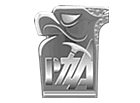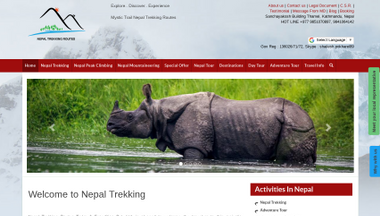K2 claimed a first victim last week; highly skilled ski-mountaineer Michele Fait slipped and fell while skiing down the Cesen route.
Iran, Afghanistan and Somalia; adventure news arrived from unusual places while a historic meet was held in Nepal, a call went out for Mongolian horses, a last word was posted on Everest spring 2009 and the Indian Ocean race reached safe harbor.
Outside the regular Karakoram updates, last week also brought an ExWeb special on the “hidden” Gasherbrums.
K2: sky-skier down Italian Michele Fait slipped and fell while skiing down the Cesen route. Ericsson and Fait had already skied 900 meters from C1 and set up C2 in a second climb last week. They were skiing back to BC when Michele suddenly plummeted and died in the fall.
Kalashnikovs traded for ice-axes on Mt. Noshaq Last year, John Mock & Kimberley O’Neil from Yosemite National Park asked climbers to help clear the landmines blocking entrance to Afghanistan’s highest peak, Noshaq (7492m). The mountain has had many ascents including the first 7000er winter climb, but never by Afghans themselves. Now four Afghan men plan to become the first locals to reach the summit of the country’s highest peak, le by project manager Louis Meunier plus guides Jean Annequin and Simon Destombes.
Sherpa climbers First Ever Meet held on 21 June in Kathmandu “Nepali mountaineers have come of age to lead their own destiny,” said one. “Does the state know the plight of Nepali climbers when they get old?” asked another. “Foreign climbers talk more about their yaks than their Sherpas,” a third chimed in. A historic first ever meet of Nepali climbers was convened in Kathmandu on 21 June. The meet was attended by 34 regional mountaineers clubs, mountaineering related association/agencies, approximately 600 Nepali climbers and 100 expedition operator representatives. Over 30 speakers, majority of them Nepali climbers, spoke on special provisions to be incorporated in the drafting of the new constitution to address concerns of Nepali mountaineers such as rescues, social security, insurance, regulations, education and retirement.
Iran: Iran is changing and so is its mountaineering: an avalanche of Iranian climbers is hitting Karakoram. Only on G2, there’s a team of 11 climbers from Tehran, a team of 2 mountaineers from Golestan, and a team of 9 alpinists from Sarab expected.
K2: Bogomolov’s comeback, take 4 “There is no justice in Heaven!” Serguey cried on K2 in 2006, after four fellow Russian climbers perished in an avalanche on the Abruzzi spur, which almost swept him with them. In 2007, he attempted K2 Chinese side, with the Kazakh National team. This season, the Russian climber is attempting K2 for the fourth time, going back for the Pak side with Kazakhs Maxut Zhumayev and Vassily Pivtsov.
GIII-GIV: The climbers planed to establish a tent in the cwm near 7000 meters.
GIII-GVI: ExWeb special on “the other Gasherbrums” While most Gasherbrum climbers shoot for the two 8000ers – GI (Hidden Peak) and GII – their “lesser” cousins GIII, GIV and GV provide a higher degree of exposure and difficulty, plus a number of unclimbed faces and ridges. Moreover GVI, located at the edge of the range, is probably virgin. Yet little is known about the lesser Gasherbrums, so last week ExWeb ran a skinny on the range.
Nanga Parbat: Three of Göschl’s team members suffered altitude and had to descend to below 4000 meters with Dr. Günther Straub. Otherwise, the climb on Nanga is progressing fast. Louis Rousseau reported that the team hopes to be ready for a first summit bid by the end of the upcoming week. Joao Garcia spent two nights in C2, at 6,000m. Korean Miss Oh reportedly arranged a chopper to airlift her the moment she returns from the summit, in order to take her to Gasherbrums’ BC.
Gasherbrum II: Altitude Junkies reported that out of the estimated six or seven expeditions currently present in base camp, few have high altitude porters. Major teams Amical, Altitude Junkies and Jagged Globe are all cooperating to prepare the mountain.
Broad Peak: Eli Revol and Ludo Giambasi failed a traverse of the mountain. Antoine turned back above C3 on the normal route. FTA’s Broad Peak team leader Chris Szymiec reported that there are a few other teams on the mountain so lines need to be fixed. The team had member Barry Dawe evacuated last weekend due to vision problems.
Last word on Everest spring 2009… Gabriel Filippi, one of the three last men standing on Everest this season, posted a debrief showing an unusual side of the usually crowded mountain. Gabriel, his cameraman and Peruvian Richard Hidalgo launched a failed summit push on Everest North side on June 6, ”Being alone on Everest has its charm,” Filippi reported. “We descended without trails, on a hidden side of Everest, across snow slopes and breathtaking traverses – a pure delight.”
…and early fall kick off? Indian-Tibetan Border Police mountaineers may attempt Everest from its south side in August, according to the Indian Express. The Indian team originally announced plans to climb and ski down Everest’s North side in spring this year, hoping to use their own encrypted communication equipment, but eventually switched to standard satellite-phones at the Chinese Authorities’ reluctance to allow such comm-gear to be used in their territory. Now the ITBP team is back in Indian headlines – reportedly going for a early fall climb on Everest, from Nepal.
ExWeb interview with Linda Beilharz, “this is a combination of excitement and fear” Linda Beilharz’ big goal is a journey on the four Icecaps of the World. She has skied to the South Pole, crossed Greenland and is on her way to the Southern Patagonia Icecap with her expedition teammate and husband, Rob Rigato. Linda talked about their different strong points, why the four Icecaps, the gear and preps in an interview with ExWeb’s Correne Coetzer.
ExWeb interview with Rob Rigato, “joining Linda was a way of supporting her in her goals” Rob is joining his wife and ExWeb’s Correne Coetzer caught up with him in Chile for his side of the story.
Exweb Week-In-Review is sponsored by HumanEdgeTech the world’s premier supplier of expedition technology. Our team helps you find ultra light expedition tech that works globally.
e-mail or call +1 212 966 1928
* Read these stories – and more! – at ExplorersWeb.com
zapraszam do subskrypcji mego bloga
Filed under: Climbers, Expedition, Karakoram, Week-In-Review | Tagged: Baltoro, Broad Peak, Climbers, Expedition, Gasherbrum, K2, Karakoram, Nanga Parbat, Sherpa, Travel | Leave a comment »





































